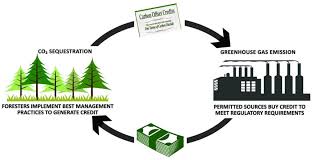In the fight against climate change, accurate tracking and reporting of carbon emissions are crucial. However, one of the major challenges in carbon offset programs and environmental initiatives is the issue of double counting—where the same emissions reductions are claimed by multiple parties.
This undermines the effectiveness of efforts to combat global warming. Blockchain technology, known for its secure, transparent, and immutable nature, offers a promising solution to this problem.
By providing a decentralized and tamper-proof ledger, blockchain ensures that carbon credits are properly tracked and verified, preventing the duplication of efforts and ensuring that emissions reductions are accurately accounted for.
In this article, we’ll explore how blockchain is revolutionizing carbon accounting and helping to create a more reliable and effective system for addressing climate change.
Read More: How Blockchain Technology Prevents Double Counting of Carbon Emissions
How Blockchain Technology Addresses the Double Counting of Carbon Emissions
The credibility of the global carbon market has recently come under intense scrutiny, raising concerns about the effectiveness of voluntary carbon markets.
As these markets continue to expand, the issue of double counting has become a focal point in discussions about whether carbon credit projects are genuinely contributing to the goals outlined in the Paris Agreement and the United Nations Sustainable Development Goals.
For companies investing in carbon credit projects, the challenge is clear: finding reliable ways to offset emissions that meaningfully support their path to net zero. To achieve this, it is critical to understand the concept of double counting and how it can be avoided.
Double counting occurs when the same carbon credit is counted multiple times within the system. This can happen when a carbon credit is either registered more than once, or sold and claimed by multiple parties.
Such practices undermine the integrity of carbon offset initiatives and raise doubts about their real-world impact on reducing global emissions. Blockchain technology offers a potential solution, ensuring transparency and preventing duplication by creating a secure, immutable ledger for carbon credits.
Why Ensuring Due Diligence on Carbon Emissions is Crucial
Ensuring due diligence in carbon emissions is fundamental to verifying that projects designed to reduce or remove carbon emissions deliver measurable and authentic environmental benefits.
This process is essential for preserving the integrity of carbon credit initiatives and preventing greenwashing, where projects may exaggerate or misrepresent their actual environmental impact.
At present, project developers rely on their own processes and methodologies to track carbon credits and report on country-level emissions data and targets. This lack of standardization in reporting can foster skepticism, diminish trust in carbon markets, and erode confidence between buyers and sellers.
For voluntary carbon markets to operate effectively as a coherent system, enabling the buying and selling of carbon credits voluntarily, it is critical that these credits stem from projects that have a genuine and positive impact on the environment.
To maintain the trust and credibility of investors, buyers, sellers, and the public, these projects must be backed by legitimate, rigorous reporting standards.
Benefits of Blockchain Technology in Tackling Double Counting
Emerging digital technologies are playing a critical role in creating a unified data system that can gather and structure carbon credit information from publicly available sources, ultimately enhancing transparency, trust, and integrity in the carbon market.
Blockchain technology, in particular, offers a powerful solution for tracking carbon footprints, transactions, and emissions data across the entire value chain, ensuring end-to-end traceability.
By utilizing decentralized ledgers, open verification systems, immutable records, smart contracts, and automated processes, blockchain can effectively address issues like double counting and ensure reliable data management.
This technological approach aligns seamlessly with the goals of Article 6 of the Paris Agreement, which encourages voluntary cooperation among countries to achieve emissions reduction targets defined in their Nationally Determined Contributions.
While Article 6 takes a bottom-up approach, allowing countries to integrate their plans into international frameworks, it currently lacks clear, concerted guidelines for linking various registry systems.
This lack of integration presents a significant challenge to accurate reporting and verification of greenhouse gas (GHG) emissions reductions.The decentralized nature of blockchain technology further enhances data security, making unauthorized changes to the data nearly impossible.
This ensures that the integrity of carbon credit information remains intact throughout its lifecycle.
As data ownership becomes an increasingly important ethical consideration in technology adoption, the benefits of blockchain in protecting data and establishing proper controls for access and management are undeniable.
Ensuring that data quality is understood, measured, and properly managed is vital for maintaining the credibility of carbon credit markets.One practical application of blockchain technology in this space is the Climate Action Data Trust (CAD Trust).
This platform leverages public, permissionless blockchain technology to address the issue of double counting. CAD Trust acts as a safeguard, preventing registry data from being reported multiple times by detecting discrepancies in the metadata layer.
The open-source data system developed by CAD Trust aggregates real-time, verifiable emissions reduction data from disparate registry systems worldwide, allowing these registries to retain control over their data on a centralized platform.
By creating an immutable, auditable, and decentralized record, it facilitates data sharing in line with the Paris Agreement and effectively identifies and prevents double counting.The growing interest in open-source, decentralized systems is evident within the carbon market community.
Platforms like CAD Trust exemplify this shift, offering a robust infrastructure that not only prevents double counting but also ensures the interoperability of carbon market systems.
As this trend continues, such tools will evolve into standardized solutions, benefiting the broader economy by enhancing the credibility and efficiency of carbon markets globally.
Frequent Asked Question (FAQs)
What is double counting in carbon markets?
Double counting occurs when the same carbon credit is claimed or recorded more than once, undermining the credibility of carbon offset programs.
How does blockchain prevent double counting?
Blockchain ensures transparency and traceability by using immutable, decentralized ledgers to track each carbon credit, preventing duplication.
Why is blockchain important for carbon credit transparency?
Blockchain provides a secure, transparent record of carbon credit transactions, ensuring data accuracy and trust in the carbon market.
How does blockchain support the Paris Agreement?
Blockchain enables transparent, decentralized reporting of emissions reductions, helping countries meet their Nationally Determined Contributions (NDCs).
What is the Climate Action Data Trust (CAD Trust)?
CAD Trust uses blockchain to prevent double counting by centralizing and securing carbon market data, ensuring real-time verification of emissions reductions.
How does blockchain enhance data security in carbon markets?
Blockchain’s decentralized nature makes it nearly impossible to alter data once it’s recorded, ensuring secure and tamper-proof carbon credit transactions.
Conclusion
Blockchain technology offers a transformative solution to one of the most pressing issues in the carbon market: double counting. By providing a transparent, secure, and decentralized system for tracking carbon credits, blockchain enhances the integrity and trustworthiness of voluntary carbon markets. This technology not only prevents the duplication of carbon credits but also supports the goals of the Paris Agreement, enabling accurate reporting and verification of emissions reductions across borders.

